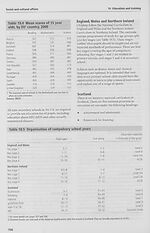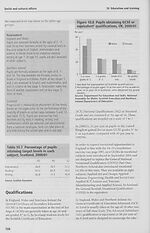Download files
Complete book:
Individual page:
Thumbnail gallery: Grid view | List view

Social and cultural affairs
10 Education and training
Table 10.6 Compulsory subjects at key stages
England Wales' Northern Ireland2
All key stages
English • • •
Welsh/lrish • •
Mathematics . • •
Science . • •
Physical education • • •
Design and • • •
Information and communications technology (Id) •
Cross curricula themes •
Key stages 1 to 3
History . • •
Geography • • •
Art and design • • •
Music . . •
Key stages 3 and 4
Citizenship •
Modern foreign language . • •
Cross curricula themes •
Humanities •
1 Design and technology is technology, which includes information and communications technology (ICT). Art and design is art. A language is
optional at key stage 4.
2 Irish is taken in Irish speaking schools. Science includes science and technology at key stages 1 and 2. Design and technology is taken at key
stages 3 and 4 only. Cross curricula themes include cultural heritage, education for mutual understanding, health education and ICT at stages
1 to 4 and economic awareness and careers education at stages 3 and 4. At key stage 4 pupils must choose a humanities subject.
■ inclusion and equality;
■ values and citizenship; and
■ learning for life.
The content and management of the curriculum
are the responsibility of educational authorities
and individual headteachers. National guidelines
for pupils aged 5 to 14 set out the ground to be
covered and the way pupils’ learning should be
assessed and reported.
There are curriculum guidelines for languages,
mathematics, ICT, environmental studies,
expressive arts, religious and moral education,
health education, and personal and social
development. Pupils can study a modern
European language during the last two years of
primary education.
There are 59 units in primary schools where
education takes place through the Gaelic language.
There are some other schools where Gaelic can be
learned as a second language.
Attainment
In 2001, at key stage 1 over 80 per cent of both
boys and girls in England achieved the expected
level in English. By key stage 3 this had fallen to 57
per cent and 73 per cent respectively. The
proportion of boys in England, Wales and
Northern Ireland reaching the required standard
for English was lower than for girls at all key
stages, particularly stages 2 and 3. This was also
true of Welsh in Wales. Similar proportions of
boys and girls reached the expected level in tests
for mathematics and science at all key stages. The
proportion of pupils achieving the expected level
generally reduced with age for both sexes.
Scotland
The percentage of pupils attaining target levels
increased between 1999/2000 and 2000/01 for
most local authorities, across all subjects. As in the
rest of the UK, the proportions of pupils achieving
107
10 Education and training
Table 10.6 Compulsory subjects at key stages
England Wales' Northern Ireland2
All key stages
English • • •
Welsh/lrish • •
Mathematics . • •
Science . • •
Physical education • • •
Design and • • •
Information and communications technology (Id) •
Cross curricula themes •
Key stages 1 to 3
History . • •
Geography • • •
Art and design • • •
Music . . •
Key stages 3 and 4
Citizenship •
Modern foreign language . • •
Cross curricula themes •
Humanities •
1 Design and technology is technology, which includes information and communications technology (ICT). Art and design is art. A language is
optional at key stage 4.
2 Irish is taken in Irish speaking schools. Science includes science and technology at key stages 1 and 2. Design and technology is taken at key
stages 3 and 4 only. Cross curricula themes include cultural heritage, education for mutual understanding, health education and ICT at stages
1 to 4 and economic awareness and careers education at stages 3 and 4. At key stage 4 pupils must choose a humanities subject.
■ inclusion and equality;
■ values and citizenship; and
■ learning for life.
The content and management of the curriculum
are the responsibility of educational authorities
and individual headteachers. National guidelines
for pupils aged 5 to 14 set out the ground to be
covered and the way pupils’ learning should be
assessed and reported.
There are curriculum guidelines for languages,
mathematics, ICT, environmental studies,
expressive arts, religious and moral education,
health education, and personal and social
development. Pupils can study a modern
European language during the last two years of
primary education.
There are 59 units in primary schools where
education takes place through the Gaelic language.
There are some other schools where Gaelic can be
learned as a second language.
Attainment
In 2001, at key stage 1 over 80 per cent of both
boys and girls in England achieved the expected
level in English. By key stage 3 this had fallen to 57
per cent and 73 per cent respectively. The
proportion of boys in England, Wales and
Northern Ireland reaching the required standard
for English was lower than for girls at all key
stages, particularly stages 2 and 3. This was also
true of Welsh in Wales. Similar proportions of
boys and girls reached the expected level in tests
for mathematics and science at all key stages. The
proportion of pupils achieving the expected level
generally reduced with age for both sexes.
Scotland
The percentage of pupils attaining target levels
increased between 1999/2000 and 2000/01 for
most local authorities, across all subjects. As in the
rest of the UK, the proportions of pupils achieving
107
Set display mode to:
![]() Universal Viewer |
Universal Viewer | ![]() Mirador |
Large image | Transcription
Mirador |
Large image | Transcription
The item on this page appears courtesy of Office for National Statistics and may be re-used under the Open Government Licence for Public Sector Information.
| Britain and UK handbooks > UK: The official yearbook of the United Kingdom of Great Britain and Northern Ireland > 2003 > (129) |
|---|
| Permanent URL | https://digital.nls.uk/204924784 |
|---|
| Attribution and copyright: |
|
|---|---|
| Description | Three volumes of 'UK: The official yearbook of the United Kingdom of Great Britain and Northern Ireland', published annually by the Office of National Statistics from 2002-2005. |
|---|---|
| Shelfmark | GII.11 SER |
| Description | Three titles produced by the British Government from 1954-2005 describing 'how Britain worked'. They are: 'Britain: An official handbook' (1954-1998), 'Britain: The official yearbook of the United Kingdom' (1999-2001), and 'UK: The official yearbook of the United Kingdom of Great Britain and Northern Ireland' (2002-2005). These 50 reports provide an overview of Britain's economic, social and cultural affairs, its environment, international relations, and the systems of government. They give an impartial summary of government policies and initiatives, and explain how public services are organised. |
|---|---|
| Additional NLS resources: |
|

